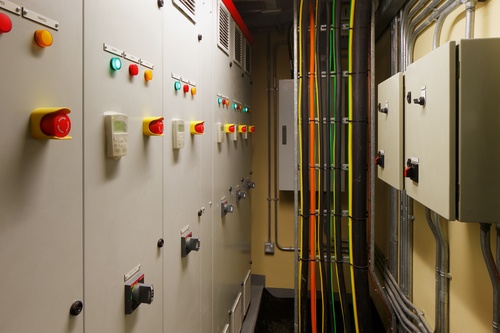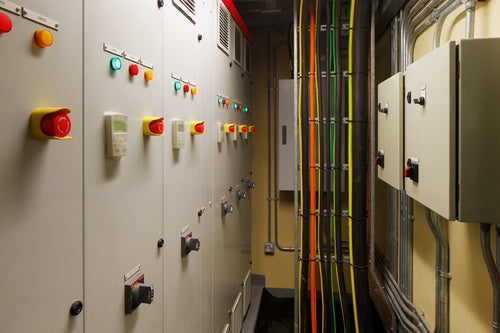In residential and commercial buildings, most components of electrical installations are hidden – only elements such as lamps and sockets are exposed, as their function requires it. The role of electrical systems in building interiors is much more evident in industrial environments, where there are no false ceilings or dry walls to hide ducts, junction boxes and other accessories.
Practically all construction systems have at least one electrical component, even if the main energy input is not electricity. For example, space heating systems rely on motorized fans to distribute air, and gas-powered equipment in commercial kitchens uses electronic controls. Electricity is normally associated with lamps, sockets and air conditioning units, but its coverage is much wider!
Electricity is the fastest and cheapest method of energy transmission known to modern society, but this also makes it dangerous. If a high magnitude current is not stopped quickly, it can easily start a fire. In the US, the National Electrical Code (NEC) NFPA 70 is the primary reference document for safely designing electrical installations. The New York Electrical Code is basically the NEC with changes and modifications specific to New York City.
Requirements for a safe electrical installation
Electrical safety does not depend on a single device and must be integrated across all electrical components.
- Electrical equipment must be manufactured safely and there are many industry associations and regulatory bodies that have taken on this responsibility in the US. The National Electrical Manufacturers Association (NEMA) and Underwriters Laboratories (UL) are perhaps the best-known examples – equipment that does not meet NEMA and UL requirements is frequently rejected.
- Electrical conductors and protections must be suitable for the equipment they supply. Even if your entire electrical system uses approved components, failures can occur due to incorrectly rated conductors and shields – the insulation on an overloaded conductor melts and oversized circuit breakers do not eliminate low-magnitude faults.
- All electrical components carrying voltage must be isolated from the public. In residential and commercial environments, powered devices are in close proximity to people of all ages and professional backgrounds. Electrical installations must be designed to avoid any type of accidental contact with energized conductors.
Requirements for electrical installations become less stringent in areas that are only accessed by trained personnel, such as mechanical and electrical rooms. Transformers and switches are dangerous to untrained personnel, even when the equipment meets all applicable codes and standards.
Energy Efficiency in Electrical Installations
A safe electrical installation is not necessarily efficient, but a professional design company will usually propose measures to help reduce your energy bills. Energy efficiency can really make your facility safer, and LED lighting is a great example of this:
- LED bulbs can be manufactured without electrical components, while most other types of bulbs are prone to breaking – incandescent, halogen, fluorescent and HID.
- LED bulbs also have a smaller thermal footprint, reducing the chance of starting a fire. Additionally, most LED bulbs won't burn your hand if accidentally touched, except those in high-wattage applications.
The electrical safety requirements of the NEC and equivalent codes are always mandatory, while energy efficiency rules change by location. For example, the New York Energy Conservation Code establishes a minimum efficiency level for buildings, but this level is significantly below the maximum efficiency possible with modern technologies.
Brief Summary of the Electrical Design Process
Many electrical design requirements are determined based on other building systems rather than directly on the owner's requirements. Consider the following examples:
- The capacity of boilers and air conditioning equipment is directly determined by the heating and cooling needs of the building. On the other hand, the corresponding electrical installation is determined by the load of motorized equipment such as fans and compressors.
- A similar concept applies to lighting design: luminaires are selected based on area and illuminance requirements, while electrical systems depend on energy consumption.
Design engineers must analyze the power requirements of the building's equipment before specifying the electrical installation that will supply that power at the correct voltage. Keep in mind that designers may suggest energy efficiency measures to reduce the total electrical load, and the following are some examples:
- NEMA Premium Efficiency motors with speed controls (VFD) for equipment above 1 HP.
- Brushless DC motors for fractional power equipment.
- LED lighting, as mentioned previously.
- ENERGY STAR appliances.
- Air conditioning equipment with intelligent compressors.
Efficient electrical equipment consumes less current, reducing the capacity of the electrical system. Significant cost reductions are possible by optimizing the capacity of wiring, load centers, panels and transformers.

Once the electrical loads have been identified and optimized, the next step is to specify suitable branch circuits to supply them. Note that some loads, such as light fixtures and electrical outlets, may share circuits.
- Electrical conduit is selected based on conductor space requirements. For example, three AWG #12 wires have a much smaller cross-section than three AWG #6 wires.
- Circuit breakers are sized based on the conductor ratings. The conductor is sized based on the load and in turn the circuit breaker is sized to protect the conductor.
- Load centers are distributed depending on the location of branch circuits throughout the building.
- Feeder circuits connect load centers to main service equipment.
- Major service equipment is sized based on total load.
Notice how all loads are combined in the service equipment, meaning the energy efficiency benefits add up. Because service equipment tends to be the most expensive to install and is typically priced based on capacity, significant savings are possible.
The National Electrical Code NFPA 70 specifies detailed requirements for each part of the electrical installation, and your building must undergo an inspection before being approved for its intended use.
Electrical engineers to speed up your project
Time is a very important factor when it comes to construction. Every small delay can potentially add exorbitant costs to the final project. Our Electrical engineers are used to dealing with tight schedules and can help you get your project on track quickly. With unparalleled knowledge of local and national construction laws, New York engineers will have your project drafted and approved quickly.
In addition to our quick turnaround, 50% faster than our competitors, we also have a lot of experience that will be beneficial to your project. New York Engineers is a company that is involved in several local and national real estate developments.
We can help you save a lot of money
Every design can be improved, but some designs can be transformed. Our value engineering service has proven to be very successful in the past and has the potential to save you a lot of money. Basically, we analyze your existing design and determine if and where it has been over-engineered. We simplify the sketch and thus reduce construction costs. Depending on the size of your project and the number of changes we make, you may see a drastic change in costs.
For this service we charge a flat fee of 10% of the total savings generated by our process. We never change the overall aesthetic element of your project and you are always guaranteed to save money.
But what about utility costs?
Here at New York Engineers, we take action to combat climate change. How will this affect you? We will try to incorporate green energy solutions into your building design. A few solar panels and batteries can help you earn a profitable ROI in the long run. Friendly for your wallet, friendly for the environment!
As a general rule, our projects are made to be as efficient as possible. After determining your energy needs, we will apply our experience to find the most energy-efficient solution for you, your home or business.
Whether you are building a warehouse or a private residence, our Electrical engineers will rise to the challenge. Why choose New York engineers over everyone else? Transparent pricing structures, fast response times, fast approvals, and unparalleled industry expertise. Request a free quote and together we can turn your dream project into reality.
Get a code-compliant and energy-efficient electrical design.
Conclusion
Electrical installations are the backbone of many building systems and must be designed for safe operation. However, overly designed electrical systems are not recommended as they drastically increase project costs.
The electrical design process offers a great opportunity to implement energy efficiency measures. These are very economical given the high kilowatt-hour prices in New York and New Jersey.

